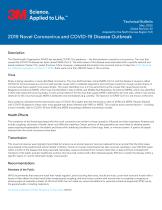
Excertos do catálogo

Technical Bulletin May, 2020 Global Revision 22 Adapted for the North Europe Region (V3) 2019 Novel Coronavirus and COVID-19 Disease Outbreak Description The World Health Organization (WHO) has declared COVID-19 a pandemic – the first pandemic caused by a coronavirus. The virus that caused the COVID-19 disease has been named SARS-CoV-2. The initial cases of this disease were associated with a specific seafood and animal market in Wuhan City, Hubei Province, China. However, widespread transmission has occurred, and as of when the WHO declared the outbreak a pandemic on March 11, 2020, there were more than 118,000 cases in 114 countries. Virus Illness is being caused by a newly identified coronavirus. The virus itself has been named SARS-CoV-2, and the disease it causes is called COVID-19. Coronaviruses are common and typically cause mild to moderate respiratory and cold type symptoms, though certain strains of coronaviruses have caused more severe illness. This newly identified virus is in the same family as the viruses that cause Severe Acute Respiratory Syndrome (SARS), which was first identified in Asia in 2003, and Middle East Respiratory Syndrome (MERS), which was identified in 2012 with cases still occurring today. A main animal reservoir for the virus that causes SARS is believed to be civet cats, while a main animal reservoir for the virus that causes MERS is believed to be dromedaries (e.g. camels). The reservoir for SARS-CoV-2 is not known at this time. Early evidence indicates that the transmission rate of COVID-19 is higher than the transmission rates of SARS and MERS. People infected with COVID-19 appear to infect many more people than those infected with SARS or MERS. This could be due to several factors – including a lower mortality rate for COVID-19 than SARS and MERS and perhaps different transmission modes. Health Effects The symptoms of the illness associated with this novel coronavirus are similar to those caused by influenza and other respiratory illnesses and include coughing, shortness of breath, fever, and difficulty breathing. Certain portions of the population are more likely to develop severe cases requiring hospitalization: the elderly and those with underlying conditions of the lungs, heart, or immune system. A portion of people infected with this novel coronavirus have died. Transmission This novel coronavirus was originally transmitted to humans via an animal reservoir (source), believed to be an animal that the initial cases encountered at the seafood and animal market in Wuhan. Human-to-human transmission has also occurred, resulting in over 100,000 cases within months of the disease first being reported. Secondary cases (contracted from humans rather than a reservoir) have included both members of the public and also healthcare workers who have had contact with other infected people. Efforts to contain the disease within a specific region or country have been largely unsuccessful. Recommendations Members of the Public WHO recommends that everyone wash their hands regularly, avoid touching their eyes, mouth and nose, cover their nose and mouth with a tissue or their elbow (not their hand) when sneezing and coughing, and avoid close contact with anyone who is coughing or sneezing or showing signs of respiratory illness. At this time WHO has not made any recommendations for personal protective equipment (PPE) use by the general public, including respirators. Coronavirus disease (COVID-19) advice for the public (WHO
Abrir o catálogo na página 1
Healthcare Workers The WHO has confirmed that aerosol transmission is a possible transmission pathway of SARS-CoV-2. WHO has published guidance intended for healthcare workers (HCWs), healthcare managers, and teams working in infection prevention and control. WHO recommends that eye protection (goggles or a face shield) be used during patient contact along with gloves, a medical mask, and a fluid-resistant gown. Airborne precautions, including an N95, FFP2, or equivalent respirator, should be used during aerosol-generating procedures. Infection prevention and control during health care when...
Abrir o catálogo na página 2
Norway The Norwegian Institute for Public Health (Folkehelseinstituttet) has advised healthcare professionals to use surgical mask and eye protection when handling and treating suspected COVID-19 patients. Please note respiratory protection mask (FFP3 (FFP2/N95) is only required by aerosol generating procedures. https://www.fhi.no/nettpub/coronavirus/helsepersonell/personlig-beskyttelsesutstyr/?term=&h=1 Sweden The Public Health Agency of Sweden (Folkhälsomyndigheten ) has advised healthcare professionals, in contact with a patient with suspected or confirmed COVID-19, to use risk- based...
Abrir o catálogo na página 3
Summary A novel coronavirus has caused a pandemic-scale disease outbreak with confirmed airborne human-to-human transmission. The situation is evolving, and it is recommended that all concerned consult the WHO and their local health authority websites frequently for the most updated information regarding this situation. 3M Resources Documents General Respiratory Protection Information • • • • • • 3M Technical Bulletin - Respiratory Protection for Airborne Exposures to Biohazards 3M Technical Bulletin - Comparison of FFP2, KN95, and N95 Filtering Facepiece Respirator Classes 3M Frequently...
Abrir o catálogo na página 4
Powered Air-Purifying Respirators (PAPRs) • • • • • 3M™ Jupiter Powered Air Turbo Unit – Assembly and Operation Video 3M™ Versaflo TR-300 Powered Air Turbo Unit – Assembly and Operation 3M™ Versaflo™ TR-300+ Powered Air Turbo Unit – Cleaning and Disinfection 3M™ Versaflo TR-600 Powered Air Turbo Unit – Assembling, Donning and Doffing 3M™ Versaflo™ TR-600 Powered Air Turbo Unit – Cleaning and Disinfection 3M Quick Reference Guide to Qualitative Fit Testing (UK) 3M Technical Bulletin - Fit Test Hygiene During COVID-19 Pandemic Video: 3M™ FT-10 and 3M™ FT-30 Qualitative Fit Testing Kits...
Abrir o catálogo na página 5Todos os catálogos e folhetos técnicos 3M Health Care
-
The Importance of Fit
1 Páginas
-
3M™ Curos™ Disinfecting port protectors
12 Páginas
-
3M™ MLS Mini UHT Dairy Screen Kit
49 Páginas
-
Warm Every Surgical Patient
2 Páginas
-
OrthodonticProduc
236 Páginas
-
Clarity
12 Páginas
-
RelyX Ultimate
2 Páginas
-
paradigm™
4 Páginas
























